Archive for April, 2016
Europeana Fashion Co-Creation Workshop in Amsterdam
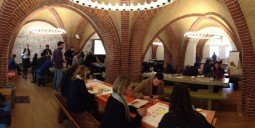
On 20th of April, Europeana Fashion held in collaboration with Platoniq a co-creation workshop in the wonderful venue of the Rijksmuseum, in Amsterdam!
On Wednesday 20th of April, 35 professionals from different institutions gathered together to attend the Co-Creation workshop organized by Europeana Fashion with the team of Platoniq, open culture developers and social innovators, to brainstorm, propose and discuss innovative ideas for the promotion of digital fashion heritage. Among the 35 participants, we had representatives of museums and archives, like MoMu Antwerp, Israel Museum, Rossimoda Shoe Museum, ModeMuze, SPK Berlin, PFF Nafplio, Netherlands Institute for Sound and Vision and Rijksmuseum, professionals of brand archives, Iike the Benetton Group, academics from the Central Saint Martins school, the College of Arts of the University of Edinburgh and the IUAV University of Venice, and various professionals and creatives, like UX designers, curators and developers.

Mauricio O'Brien giving a welcoming speech at the Co-Creation workshop at Rijksmuseum, Amsterdam. Photo by Europeana Fashion,CC-BY-SA.
The participants were welcomed by staff of the Rijksmuseum that co-organised and hosted the workshop. After a welcoming speech by Marco Rendina, Technical Director of Europeana Fashion International Association, Mauricio O’Brien and Olivier Schulbaum from Platoniq introduced the aims of the workshop and the way they would have been achieved during the day.
At their arrival participants were asked to identify themselves as curators, designers and producers and to divide in groups: the first task for each group was to identify an interesting or useful app, website or project related to fashion heritage and analyze which were the valuable and weak points of the product.
The next step was to fill out a chart with new possible scenarios in which specific users, such as students, researchers, scholars, curators or just fashion enthusiasts, had to complete a specific task, and inventing for them an instrument to solve their problems or fulfil their needs More than 25 interesting ideas were proposed, voted and ranked to end up with a final selection of five
These five ideas evolved, through fast prototyping, into wireframes. “Spot it”, for example, is an update on a classic-style mobile app using Europeana Fashion’s dataset, where a user can shoot or upload a photo, and perform a synthetic search for similar items in the Europeana database; while “Fashion Pockets” has been conceived to allow users to select, group and store different items together. “Accessory Search” offers curators of historical costume exhibitions the possibility to find all the information they need about special accessory objects. “Fashion Time Machine” will give instructions and patterns for the re-creation of historical fashion objects; “Pattern Finder” for vintage clothing, knitwear and craft enthusiasts, who can search this site for re-usable, public domain, shareable patterns for tailoring, knitting, crocheting and “Europeana Research”, a search tool, through which one could perform very detailed searches and receive excellent results with many related items which could be offloaded to a personal space.

The participants sharing ideas, comments, evaluations at the Co-creation workshop with Platoniq at Rijksmuseum, in Amsterdam. Photo by Europeana Fashion, CC-BY-SA.
During the workshop the attendants also assisted to short lesson on Creative Commons licenses and the Europeana Publishing Framework. Some of the partners had also curated a selection of twelve objects from their collection, that was shown during this short introduction to image licensing and re-use. These selections of pictures from the collections of Europeana Fashion’s partners, The Israel Museum, Peloponnesian Folklore Foundation and Netherland Institute for Sound and Vision, are now accessible on Europeana Fashion’s Pinterest!

The participants at the Co-creation workshop with Platoniq at Rijksmuseum, in Amsterdam. Photo by Europeana Fashion, CC-BY-SA.
The results of the fruitful day of collaboration are now to vote, and the project that will be elected as a winner, will be furtherly developed and eventually realized. Stay tuned to learn which idea will eventually be produced, or to learn more about the next events, workshops and edit-a-thons!
Maria Monaci Gallenga: a printing revolution.
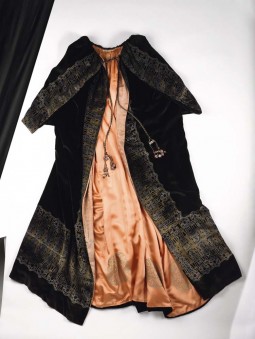
Daughter of academics and grown up surrounded by famous writers and artists of her time, the fashion and textile designer Maria Monaci Gallenga has innovated the fashion industry, introducing a special printing technique.
The invention consisted in using wooden moulds to apply glue on textiles in order to decorate the motif with gold and silver metallic pigments. Her particular way to combine the colours made the motifs look like painted instead of printed. Inspired by the past and the Renaissance period in particular, her hand-stenciled designs have been often compared to the ones of Fortuny.
She started to show her interior design works in 1913 through the Roman Secession exhibition and later in 1915 she conquered the US market, presenting a womenswear collection of 22 printed fashion objects at the Panama-Pacific Exposition in San Francisco, where she achieved such a great success that some of her works are still conserved by Metropolitan Museum of New York. Thereafter, she expanded her laboratory into a factory able to supply the American market demand, revealing a strong entrepreneurial attitude.
In the same year Maria Monaci Gallenga started to work in partnership with Vittorio Zecchin, participating to several exhibitions around Europe. In 1924 she worked with Antonio Maraini for the Biennale of Venice. Since then she often worked in collaboration with the most famous artists of her time, as Galileo Chini, Gino Sensani, Romano Romanelli, who provided the patterns for her printed fabrics. Sensitive and engaged in the cultural debates of her time, she also founded an association to promote the Italian craftsmanship in the world.
After showing her creations in her own pavillion decorated by the Italian artist Antonio Maraini at the Exposition International des Arts Deoratifs in Paris in 1925 her succes was so wide that she opened a boutique in Paris with Bice Pittoni and Carla Visconti di Modrone. The shop, called Boutique Italienne, showed the best Italian works of art, until 1934, when she decided to close it and come back to Rome.
Discover more Gallenga’s printings on Europeana Fashion Portal
Callot Soeurs

During April, Europeana Fashion will explore the history of couture, dedicating each week to a different couturier. The second issue focuses on Callot Soeurs, a Parisian fashion House ran by three innovative sisters, quoted as one of the greatest in Marcel Proust novel “À la Recherche du Temps perdu”.
One of the most influential and successful Parisian fashion houses of the 20th century, Callot Soeurs had shops in Paris, London and Buenos Aires and an exclusive clientele all across Europe and United States. Although their work was immortalized in the art of Giovanni Boldini and in the nostalgic novel of Marcel Proust, they were almost forgot in a mainstream fashion history. Only in 1990s their reputation was revived through the display of their works in fashion and costume exhibitions and museums.

Evening gown designed by Callot Soeurs, 1907-1910 ca. Collection Galleria del Costume di Palazzo Pitti.
Callot Soeurs founded their business in 1895 and were initially four, Marie Gerber, Marthe, Regine and Josephine, the youngest who sadly committed suicide in 1897. Descending from a family which dealt with art and textiles – their father was a painter and antiquarian, their mother a lace-maker descending from a lace-makers family – they were accustomed to precious fabrics, lingerie and laces their family shops were renowned for. Lace, indeed, was one of the fabrics that most characterized the sisters’ work, Marcel Proust himself noted in his novel that the Sisters used “a little too much” of it! Their couture gowns were realized with hand-made lace, usually reconstituted 18th century lace. However, they also introduced more innovative fabrics such as gold and silver lamé and a more elastic gabardine for their sport couture.

Silk damask tea-gown trimmed with lace, designed by Callot Soeurs, Paris, ca. 1905. Collection Victoria and Albert Museum, CC-BY-SA.
A business ran by women for women, they were also among the first to abandon the corset for less constrictive silhouettes. Marie Gerber, the elder sister, had a design talent besides having trained herself as a premiere in the atelier of Raudnitz & Cie. Inspired by the Orientalism and avant-garde arts, she eventually designed also Cubist dresses, made of laces and embroideries resembleing collages. She used to drape fabrics on models and let her toile-makers to execute the design. One of these toile-makers was, from 1901 to 1906, Madeleine Vionnet. In future, she would have recognized Callot Soeurs as being those who inspired her to became the great couturier she was, by saying that “without the example of the Callot Soeurs, I would have continued to make Fords. It is because of them that I have been able to make Rolls Royces”.

“Le Style Parisien”, Ice Skating outfits by Chéruit, Premet, Callot, Jenny, Lanvin and Paquin. Collection Anna Russ, Kunstbibliothek, Staatliche Museen zu Berlin, CC-BY-NC-SA.
After the death of Marie Berger, the couture house was run by her sons Pierre and Jacques, who continued to sell to the House’s loyal clientele. However, the economic crash of the 1929 had a great impact on the business, who eventually closed in 1937.
Stay connected to Europeana Fashion’s Facebook page to learn more about Callot Soeurs and through a selection of pictures from Europeana Fashion’s collection!
“Fashion Forward, Three Centuries of Fashion” at Musée des Arts Decoratifs
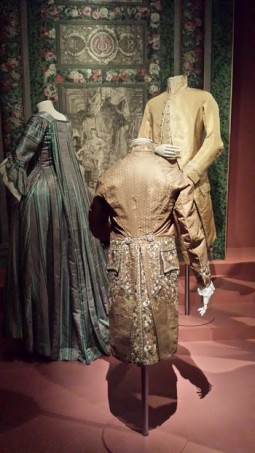
Musée des Arts Décoratifs in Paris celebrates the 30th anniversary of its fashion collection displaying three hundred years of fashion in its new exhibition, on show through the 14th August 2016.
Consisting of three hundred pieces of menswear, womenswear, childrenswear and jewels meticulously selected from the Musée des Arts Décoratifs’ s collection, which counts more than 150,000 pieces, the exhibition “Fashion Forward, Three Centuries of Fashion” has set the occasion for the Museum to conceive an ideal museum of fashion.

Mariano Fortuny’s “Delphos” dress, on the left, and two creations by Charles Frederick Worth on the right, on show in “Fashion Forward, Three Hundred Years of Fashion”, at Les Arts Décoratifs. Photo by Alessandra Arezzi Boza, CC-BY-SA.
The garments on display range from richly embroidered suits from the late 18th century to a Comme des Garçons’ S/S 2015 deconstructed robe till an H&M latest S/S 2016 special edition outfit, passing through the 19th century crinolines and the game changing creations of the 20th century couturiers of the likes of Paul Poiret, Madeleine Vionnet and Cristòbal Balenciaga. It offers a chronological overview of the history of fashion, including some of its most emblematic pieces.

An embroidered Kimono by Babani, on show in “Fashion Forward, Three Centuries of Fashion”, at Les Arts Décoratifs. Photo by Alessandra Arezzi Boza, CC-BY-SA.
Displayed for the first time in the Nave of the museum, outside their restrictive cases, the objects are set in dialogue with the other departments dedicated to decorative arts, re-creating through glimpses and ellipses the “fashion moments” and contextualizing these creations in their historical and social period. Moreover, Musée des Arts Décoratifs entrusted to the British dancer and choreographer Christopher Wheeldon, who transformed every stage of the exhibition into a word itself, together with the help of the scenographer Jérôme Kaplan assisted by Isabelle Vartan. Exploring in this way the indissoluble connection between fashion and body, the Museum also collaborated with the dancers of the Opéra de Paris, whose choreography enlightens how silhouette, body and posture evolved along with fashion.

An overwiew on the 20th century fashion, including iconic pieces from the 1980s, on show in “Fashion Forward, Three Centuries of Fashion”, at Les Arts Décoratifs. Photo by Alessandra Arezzi Boza, CC-BY-SA.
Musée des Arts Décoratifs fashion collection, browsable through Europeana Fashion portal, ranges from ancient textiles to haute couture creations and iconic ready-to-wear silhouettes, including not only accessories, but also photographs and designers’ sketches and archives, like Elsa Schiaparelli’s Madeleine Vionnet’s and Cristobal Balenciaga’s ones. Such an extensive collection is the result of the blend of the collection of the Musée des Arts Décoratifs, started on 1864, and that of the Union Française des Arts du Costume (UFAC), founded in 1948 and currently presided by Pierre Bergé, which is preserved by the Museum.
The exhibition “Fashion Forward, Three Centuries of Fashion” is on show at Musée des Arts Décoratifs through the 14th of August. For more information, please visit Les Arts Décoratifs. Browse the digital collection of the museum on Europeana Fashion!
Vitaldi Babani
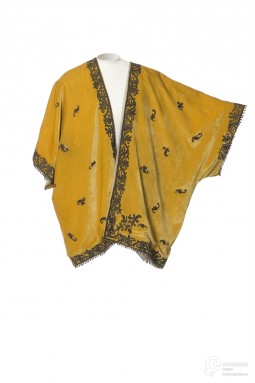
During April, Europeana Fashion will explore the history of couture, dedicating each week to a different less-known couturier. The first issue focuses on Vitaldi Babani, a textile importer turned into a designer, whose robe japonaise became a must for every fashionable woman in Paris.
A Frenchman born in the Middle East, Vitaldi Babani founded the fashion house of Babani in 1894. His boutique, set on Boulevard Gassmann, originally sold exotic goods imported from the Middle and Far East, such as embroideries, fabrics, rugs, furniture and artworks, but also oriental costumes and garments.

Manteau du soir in yellow velvet, designed by Babani in 1915/1920. Collection Les Arts Décoratifs, all rights reserved.
His nagajuban, kimono under garments, became a must for every fashionable woman in Paris after a successful series of advertisements published from 1905 on the French fashion magazine “Le Figaro-Madame”, refiguring upper-class women wearing the robe japonaise as elegant peignoirs.

1900-10 advertisement showing a Western woman wearing a Japanese kimono imported by Babani. Source Wikimedia Commons: http://bit.ly/1UZ3VeW
Paris and the European society were at the time fascinated by the art of the East, and it was use of many couturiers to get inspired by the volumes and ornamentation of the eastern traditional costumes to create their designs. Inspired by the goods he imported, Babani did that too, reproducing these costumes with luxurious fabrics and materials, such as precious silks and velvets.
Alongside his creations and oriental goods, Babani was also a licensed seller of Liberty textiles and – together with Paul Poiret in Paris – of the designs of the Venetian based couturier Mariano Fortuny, whose aesthetic was also reminiscent of a certain Orientalism.

"Delphos" dress, designed by Mariano Fortuny, 1920 ca. Photo by Stephan Klonk. Collection Kunstgewerbemuseum, Staatliche Museen zu Berlin, CC-BY-NC-SA.
From 1919, the son of Vitaldi, Maurice, joined Babani and carried on the business. He launched a series of perfumes that, accordingly to the fashion house’s style, bore exotic names, such as Afghani (1920), Yashmak (1924), Abdulla (1926) and Sousouki (1921).
Stay connected to Europeana Fashion’s Facebook page to learn more about Babani and his time and world through a selection of pictures from Europeana Fashion’s collection!
Stephen Jones and the art of Millinery
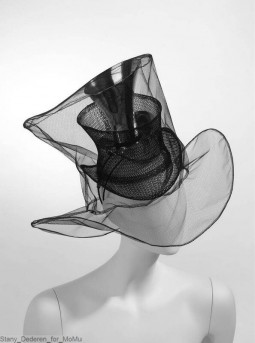
Born in 1957 in Cheshire, Stephen Jones studied at Saint Martin’s School of Art where he was the sole male student in his year.
In 1979 he left the punk scene to embrace the New Romantic movement when he became a regular attendee of London’s Blitz nightclub in Covent Garden. As one of the “Blitz Kids” he used to meet Spandau Ballet, Duran Duran, Isabella Blow and Jean Paul Gultier. Also he shared a house with Boy George and Grayson Perry. Many of the Blitz Kids became his first clients and Jones created outlandish hats for them to wear to the club.
In the same year, Jones designed a line of hats for Fiorucci. The next year the Blitz’s owner Steve Strange decided to invest on his talent and made him open his first millinery salon, in Covent Garden. After this first success, in 1982, Jones had his debut at Paris fashion week and Princess Diana became a regular costumer. Also he started a lucky collaboration with Victoria & Albert Museum, which began with one hat commissioned for their newly refurbished Costume Court and culminated in 2009 with the Hats: An Anthology exhibition.
Through his career Jones has created hats for the catwalk shows of many leading couturiers and fashion designers, such as John Galliano at Dior and Vivienne Westwood. An ambitious style, his inventiveness and the high level of technical expertise with which he realises his ideas are the reason he is now considered one of the world’s most important milliners of the late 20th century.
Ensemble designed by Jean Paul Gaultier and hat by Stephen Jones, 1985. Courtesy of Les Arts Décoratifs, Paris
Search through Europeana Fashion Portal other fabulous Stephen Jones‘ creations.
Barbie at Les Arts Décoratifs

Protagonist of an exhibition in France for the first time, Barbie will be the guest star at Les Art Decoratifs in Paris from the 10th of March to the 18th of September.
Born Barbara Millicient Roberts, from Wisconsin, the famous doll was created by Ruth Handler, one of the Mattel’s founders, who wanted to replace her daughter’s (Barbara) paper doll with a three-dimentional doll, which had to be like a mannequin. Ruth was so determined to innovate the young girl’s entertainment, to convince an entire male working group to create Barbie. Since that moment her story has been written, overlooking her age, to let her identify with a teen ager as well as with a young girl.
Maybe nobody in the team in 1959 would have imagined the huge success Barbie would have acheived . Across the years, the famous doll has been a schoolgirl, a nurse or an hostess, and these are just three of more than 150 professional roles she played. She has been a veterinarian more than once, a paleontologist, a computer technician, a racer, a teacher, a doctor, a police-woman, for four times a candidate for Presidential elections and an astronaut in 1965, to celebrate the Armstrong’s moon landing. Barbie’s has an history of successes, marked by amazing outfits, from the strangest to the most glamourous, sometimes designed by big names of fashion. With her pop charm she has kept the attention of Andy Warhol too, who dedicated one of his iconic paintings to her.
The tradition of the “poupée de mode” has its origins in the 18th century, when this term referred to three different objects: the little girl’s doll, the miniature of the dress which had to be realized in real measures and the mannequin used in the boutiques. In that period the fashion industry was quite important in the French economic system and it played an essential role in culture. The dressed doll’s mission was to be sent all around the world to export French’s fashion trends. Queen Marie Antoinette herself used to send some dolls to her sisters to share with them the beauty of the fabrics made in Lyon.
The difference between the “poupée de mode” and Barbie is that the American doll has always been the only protagonist with a strong identity, while the French doll played just the role of mannequin to show and sell magnificent dresses around the world. Anyway both of them have been a marketing phenomena.No other toy until today has had such a strong influence in girl’s education: in fact, Barbie has inspired tastes and habits of many generations of girls since her launch on the market.
Discover amazing Barbie’s items from our archive on Europeana Fashion Portal
Exhibition “Haute-à-Porter” at Modemuseum Hasselt!

Changes are part of the radical nature of fashion. Not only periodically fashions changes, but its structures, rules and practices do it continuously. From couturiers and createurs it turned to designers and art directors, from hand-made, to machine-made, from couture to prêt-à-porter.
But this doesn’t mean that fashion does not cross and mix these worlds, taking inspirations and introducing in contemporary prêt-à-porter the craftsmanship, luxury and extravagance of the haute couture. Modemuseum Hasselt’s new exhibition “Haute-à-Porter” focuses on this theme to explore the practices of the last 30 years of fashion.

A contemporary crinoline dress by Yohji Yamamoto SS 1999. Photography René Habermacher, Fashion editor - Curator Filep Motwary, Film Director Thibault Della Gaspera, Model Ola Rudnicka at Next Model Management, Hairstylist Panos Papandrianos, Make-Up Yannis Siskos, Production Manager Eve Demoen, Project Director Kenneth Ramaekers, Light assistant Sebastien Meulenberg, Digital assistant Karim Nuyttens, Retouching Dimitris Rigas. Modemuseum Hasselt © 2016
Curated by Filep Motwary, costume designer, fashion journalist and founder of The Kinsky, the exhibition will be on show through the 11th September 2016. It gathers the work of many great contemporary fashion designers and houses – like Chanel, Dior, Comme des Garçons, Alexander McQueen, Ann Demeulemeester, Mary Katrantzou, Thom Browne and John Galliano, among others – and shows it besides the photos of the photographers who captured these creations and a selection of films and artworks.
Dissecting the cross-reference of prêt-à-porter and haute couture through various themes, the exhibition highlights the nature of fashion industry while decoding the elements that characterized the couture and are now intrinsic features of contemporary fashion.

Dress by Vivienne Westwood FW 2015-16. Photography René Habermacher, Fashion editor-Curator Filep Motwary, Film Director Thibault Della Gaspera, Model Ola Rudnicka at Next Model Management, Hairstylist Panos Papandrianos, Make-Up Yannis Siskos, Music H.O.P.E Not "Sorry", Production Manager Eve Demoen, Project Director Kenneth Ramaekers, Light assistant Sebastien Meulenberg, Digital assistant Karim Nuyttens, Retouching Dimitris Rigas. Modemuseum Hasselt © 2016
In addition, this April Europeana Fashion tumblr will be curated by Filep Motwary and Modemuseum Hasselt, which will feature a selection of pictures commented by the curator Filep Motwary, offering precious and interesting insights on the exhibition themes.
For more information about the exhibition please visit Modemuseum Hasselt. Browse also the museum’s collection on Europeana Fashion and visit every day our Tumblr to find a new picture of the digital curation by Filep Motwary and the Modemuseum!
From the collection: Melissa Shoes by Zaha Hadid
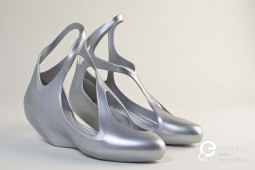
Great architect Dame Zaha Hadid recently disappeared leaving a vast heritage which goes beyond architecture and includes experimentation with accessory and footwear design.

The shoes designed by Zaha Hadid Architects for Melissa in 2009. Collection Mude - Museu do Design e da Moda, all rights reserved.
MUDE – Museu do Design e da Moda holds in its collection a pair of the shoes Zaha Hadid’s studio designed in collaboration with the Brazilian shoe brand Melissa in 2009. Inspired by the organic contours of the body, the shoes express the studio’s characteristic sense of fluidity through their seamless, liquid shape, referencing Hadid’s signature buildings.

The packaging for the shoes designed by Zaha Hadid Architects for Melissa in 2009, designed by the Studio as well. Collection Mude - Museu do Design e da Moda, all rights reserved.
Developed through advanced digital modeling techniques and employing plastic injection moulds and rapid prototyping technologies, these shoes are as a result a testimony of the collaboration of two great innovators in the world of architecture and design. The signature aesthetic of the studio was also translated in the form and details of the packaging for the shoes.
Hadid, the first woman to receive the Royal Institute of British Architects Gold Medal in recognition of her work, set up her own studio Zaha Hadid Architects in 1979. Over her long and prolific career, she was commissioned many buildings all over the world, the Vitra Fire Station in Weil am Rhein in Germany, the MAXXI Museum in Rome, the Serpentine Sackler Gallery in London, the Guangzhou Opera House in China and London Aquatics Centre in Stratford, used for the Olympics and Paralympics. Her experience with fashion does not limit to footwear design. Hadid and her studio collaborated also with Atelier Swarowski, creating a collection of beautiful crystal jewelry, and with Louis Vuitton, reinventing the iconic bucket bag.









